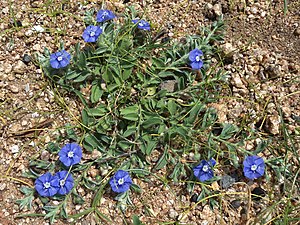Note: This is a project under development. The articles on this wiki are just being initiated and broadly incomplete. You can Help creating new pages.
Difference between revisions of "Evolvulus alsinoides - Vishnukanti"
(→External Links) |
(→Photo Gallery) |
||
| Line 68: | Line 68: | ||
==Photo Gallery== | ==Photo Gallery== | ||
<gallery class="left" caption="" widths="140px" heights="140px"> | <gallery class="left" caption="" widths="140px" heights="140px"> | ||
| − | File:Dwarf Morning-glory (Evolvulus alsinoides) in Talakona forest, AP W IMG 8527.jpg | + | File:Dwarf Morning-glory (Evolvulus alsinoides) in Talakona forest, AP W IMG 8527.jpg}|Flower |
| − | File:Evolvulus alsinoides 1DS-II 3-3470.jpg | + | File:Evolvulus alsinoides 1DS-II 3-3470.jpg|Flower |
| − | File:Evolvulus alsinoides habit.jpg | + | File:Evolvulus alsinoides habit.jpg|Plant |
| − | File:Dwarf Morning-glory (Evolvulus alsinoides) in Hyderabad, AP W IMG 9508.jpg | + | File:Dwarf Morning-glory (Evolvulus alsinoides) in Hyderabad, AP W IMG 9508.jpg|Form |
Revision as of 11:31, 18 May 2019
Vishnukranti is a tiny prostrate spreading herb with silky hairy leaves and bright blue flowers. It can be found throughout India in gravelly and grassy places.
Contents
- 1 Uses
- 2 Parts Used
- 3 Chemical Composition
- 4 Common names
- 5 Properties
- 6 Habit
- 7 Identification
- 8 List of Ayurvedic medicine in which the herb is used
- 9 Where to get the saplings
- 10 Mode of Propagation
- 11 How to plant/cultivate
- 12 Commonly seen growing in areas
- 13 Photo Gallery
- 14 References
- 15 External Links
Uses
Insomnia, Bleeding disorders, Improves memory [1]
Parts Used
Chemical Composition
Common names
| Language | Common name |
|---|---|
| Kannada | vishnukranti, shankhapushpi |
| Hindi | sankhpushpi, shankaveli, visnukranta |
| Malayalam | krsnakranti, vishnukranthi |
| Tamil | paracitam, potakiranti, potakiranticceti, villakkiranti, vishnukranti |
| Telugu | vishnukraantha, visnukrantamu |
| Marathi | NA |
| Gujarathi | NA |
| Punjabi | NA |
| Kashmiri | NA |
| Sanskrit | shankhapushpi, nilapushpi, sankhaholi, vishnukranti |
| English |
Properties
Reference: Dravya - Substance, Rasa - Taste, Guna - Qualities, Veerya - Potency, Vipaka - Post-digesion effect, Karma - Pharmacological activity, Prabhava - Therepeutics.
Dravya
Rasa
Guna
Veerya
Vipaka
Karma
Prabhava
Habit
Identification
Leaf
| Kind | Shape | Feature |
|---|---|---|
| Simple | alternate | Leaves more or less distinctly in 2 rows, 6-12 x 4-7 mm, broadly elliptic to elliptic-lanceolate, base rounded or acute, apex subacute, adpressed pilose on both sides; petiole to 2 mm long. |
Flower
| Type | Size | Color and composition | Stamen | More information |
|---|---|---|---|---|
| Bisexual | Solitary or paired at axils | Blue | 10 | pedicels to 5 mm long, silky hairy; bracts linear, c. 1 mm long. Calyx lobes 2-3 mm long, lanceolate, silky hairy. Corolla c. 1 cm across, rotate, subentire, blue. Ovules 2 in each cell; styles 2, each longitudinally 2-fid. |
Fruit
| Type | Size | Mass | Appearance | Seeds | More information |
|---|---|---|---|---|---|
| A capsule | 1.5-2 mm across | globose, 2-valved | Seeds usually 4, minute. | {{{6}}} |
Other features
List of Ayurvedic medicine in which the herb is used
Where to get the saplings
Mode of Propagation
How to plant/cultivate
Season to grow
Soil type
Propagation
Commonly seen growing in areas
Photo Gallery
References
External Links
Categories:
- Ayurvedic Herbs known to be helpful to treat Insomnia
- Ayurvedic Herbs known to be helpful to treat Bleeding disorders
- Ayurvedic Herbs known to be helpful to treat Improves memory
- Herbs with Root used in medicine
- Herbs with common name in Kannada
- Herbs with common name in Hindi
- Herbs with common name in Malayalam
- Herbs with common name in Tamil
- Herbs with common name in Telugu
- Herbs with common name in Sanskrit
- Habit - Herb
- Index of Plants which can be propagated by Seeds
- Herbs that are commonly seen in the region of Tropical area
- Herbs
- Herb
- Ayurvedic herbs that don't have flower, fruit and leaf photos
- Ayurvedic herbs that don't have seed photos



